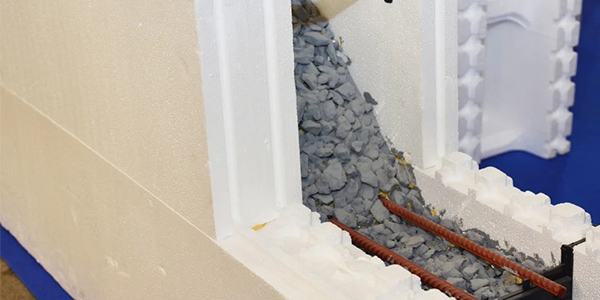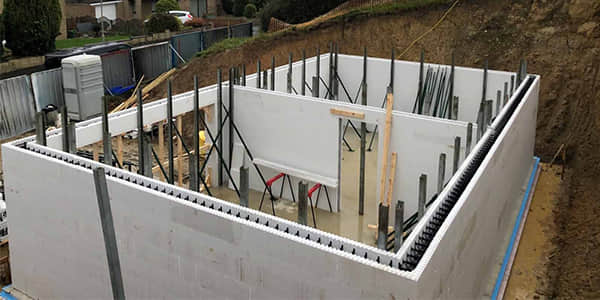Un aperçu détaillé des coffrages isolants pour béton (ICF)
Sep 10, 2025Le secteur de la construction offre des opportunités, avec une demande croissante d'efficacité, de durabilité et de résilience. Le modèle économique des constructions traditionnelles à ossature bois et en blocs de béton a fait son temps, et de nouveaux systèmes aux performances améliorées constituent une avancée révolutionnaire. Le large éventail de développements dans le secteur de la construction comprend plusieurs innovations technologiques majeures, notamment le système de coffrage isolant pour béton (CIB). Pour les architectes, les constructeurs et les fournisseurs qui souhaitent rester compétitifs, comprendre les CIB n'est plus une option ; c'est une nécessité.

Un ICF est un système de mur en béton coulé sur place utilisant des blocs ou panneaux de mousse creux comme coffrage. Ces blocs et panneaux sont empilés comme des blocs LEGO, puis remplis de béton armé. La principale différence réside dans le fait qu'avec un ICF, la mousse reste en place après le durcissement du béton, tandis que les coffrages traditionnels sont retirés. L'objectif de l'utilisation de mousse est de fournir une couche isolante continue et performante à l'enveloppe du bâtiment.
Cette double fonction de la mousse permet Systèmes ICF Révolutionnaire. La mousse assure la forme du mur porteur et l'isolation thermique, en place de manière permanente, combinant les étapes de construction en une seule opération claire.

Le matériau principal des coffrages ICF est la mousse de polystyrène expansé (PSE). Le PSE est un matériau léger, durable et hautement isolant, résistant à l'humidité et aux moisissures. Les blocs de mousse sont généralement maintenus ensemble par des entretoises en plastique ou en acier qui fixent les composants intérieurs et extérieurs, constituant ainsi la cavité du béton.
Cette combinaison de matériaux donne un mur qui est :
Les ICF offrent un ensemble d’avantages convaincants qui intéressent directement les constructeurs, les développeurs et les distributeurs.
Efficacité énergétique exceptionnelle : C'est peut-être le facteur le plus important ! L'isolation continue en mousse et la masse thermique du béton confèrent à l'enveloppe du bâtiment une efficacité énergétique exceptionnelle. La consommation d'énergie pour le chauffage et la climatisation peut être réduite de 30 à 70 % selon le climat par rapport à une construction à ossature bois classique, ce qui permet aux propriétaires de réaliser d'importantes économies d'énergie à long terme. Les coffrages isolants permettent également de réduire considérablement les infiltrations d'air, et donc les courants d'air et les variations de température intérieures. Résultat : un confort de vie (ou de travail) accru, avec l'avantage supplémentaire de réduire les factures d'énergie. Le confort, synonyme de liberté économique, devient un argument de vente fort pour les nouveaux acquéreurs et les clients professionnels.
Temps de construction plus rapide : Les coffrages isolants permettent de gagner en efficacité dans le processus de construction. En combinant les composants de coffrage, d'isolation et de structure, les équipes peuvent ériger les murs beaucoup plus rapidement que les méthodes de construction traditionnelles. Ces gains d'efficacité permettent non seulement de raccourcir les délais de construction, mais aussi de réduire les coûts de main-d'œuvre associés. De plus, grâce à leur légèreté, leur maniabilité et leur s'emboîtant facilement, les blocs CIB permettent même aux petites équipes d'optimiser la productivité sur chantier. L'érection de murs avec des coffrages isolants est également plus simple que les méthodes traditionnelles. Une fois les murs empilés et contreventés, il suffit de couler le béton et le mur est terminé. Les méthodes traditionnelles, en revanche, comprennent des étapes distinctes pour la pose de la charpente, du revêtement, de l'isolation et des pare-vapeur.
Excellente résistance : Un noyau en béton massif, qui est une structure monolithique, offre une résistance bien supérieure aux phénomènes météorologiques violents tels que les ouragans, les tornades et les tremblements de terre ! Les maisons et bâtiments en coffrage isolant sont très sûrs, solides et résilients ! De plus, la masse en béton offre une excellente résistance au feu, ce qui renforce la sécurité de votre propriété et peut même réduire vos primes d'assurance. Il est toutefois important de noter que les murs d'une construction en coffrage isolant ne devraient pas prendre feu, car ce sont principalement les composants inflammables généralement utilisés dans les constructions à ossature bois qui peuvent déclencher des incendies. Les murs en coffrage isolant sont largement résistants aux nuisibles, comme les termites, qui peuvent nuire aux maisons et bâtiments (particulièrement coûteux) en ossature bois. En résumé, la durabilité et la longévité des matériaux de construction en béton comme la technologie coffrage isolant sont importantes.
Atténuation sonore améliorée : Le béton et la mousse forment une épaisse barrière qui atténue considérablement les bruits extérieurs, améliorant ainsi l'environnement acoustique intérieur et rendant l'environnement plus calme et confortable. C'est un atout majeur pour les bâtiments en milieu urbain ou situés à proximité de rues passantes. L'amélioration des performances acoustiques constitue un atout majeur, conférant des caractéristiques haut de gamme à tout espace construit en coffrage isolant, quel que soit son type, qu'il s'agisse d'une résidence, d'une école ou d'un immeuble de bureaux.
Durabilité et durabilité : Les CIB favorisent les pratiques de construction écologiques : moins on consomme d'énergie, plus l'empreinte carbone est faible sur la durée de vie d'un bâtiment. De plus, leur durabilité implique moins d'entretien et une durée de vie plus longue que celle des CIB. Coffrage en bois Structures. Les coffrages isolants utilisent des matériaux non toxiques qui ne dégagent pas de produits chimiques dangereux, améliorant ainsi la qualité de l'air intérieur. De nombreux systèmes contiennent des matériaux recyclés, ce qui renforce leur caractère écologique.
Bien que les ICF offrent des avantages impressionnants, il est important de reconnaître certains inconvénients potentiels.
Pour les cabinets d'architectes, les entreprises de construction et les fournisseurs de matériaux de construction, adopter Coffrages isolants pour béton Il s'agit d'une décision avant-gardiste. Les coffrages isolants ne sont pas seulement un produit ; ils constituent un système offrant une solution de construction performante, durable et pérenne, répondant aux exigences de la construction moderne.
Alors que le secteur évolue vers des normes de construction plus écoénergétiques et plus résilientes, les projets réalisés avec des CIB ont de meilleures chances de réussite. En comprenant et en promouvant cette technologie, vous pouvez offrir une valeur ajoutée supérieure à vos clients, rationaliser vos opérations et capitaliser sur l'avenir de la construction écologique. Les avantages à long terme en termes d'économies d'énergie, de durabilité et de confort des occupants font des CIB un choix attrayant et responsable pour tout projet de construction.
Puis-je fixer n’importe quel type de finition extérieure sur un mur ICF ?
Est-il difficile d’installer des lignes de plomberie et d’électricité dans un mur ICF ?
Les ICF sont-ils un matériau de construction durable ?
MOTS CLÉS :